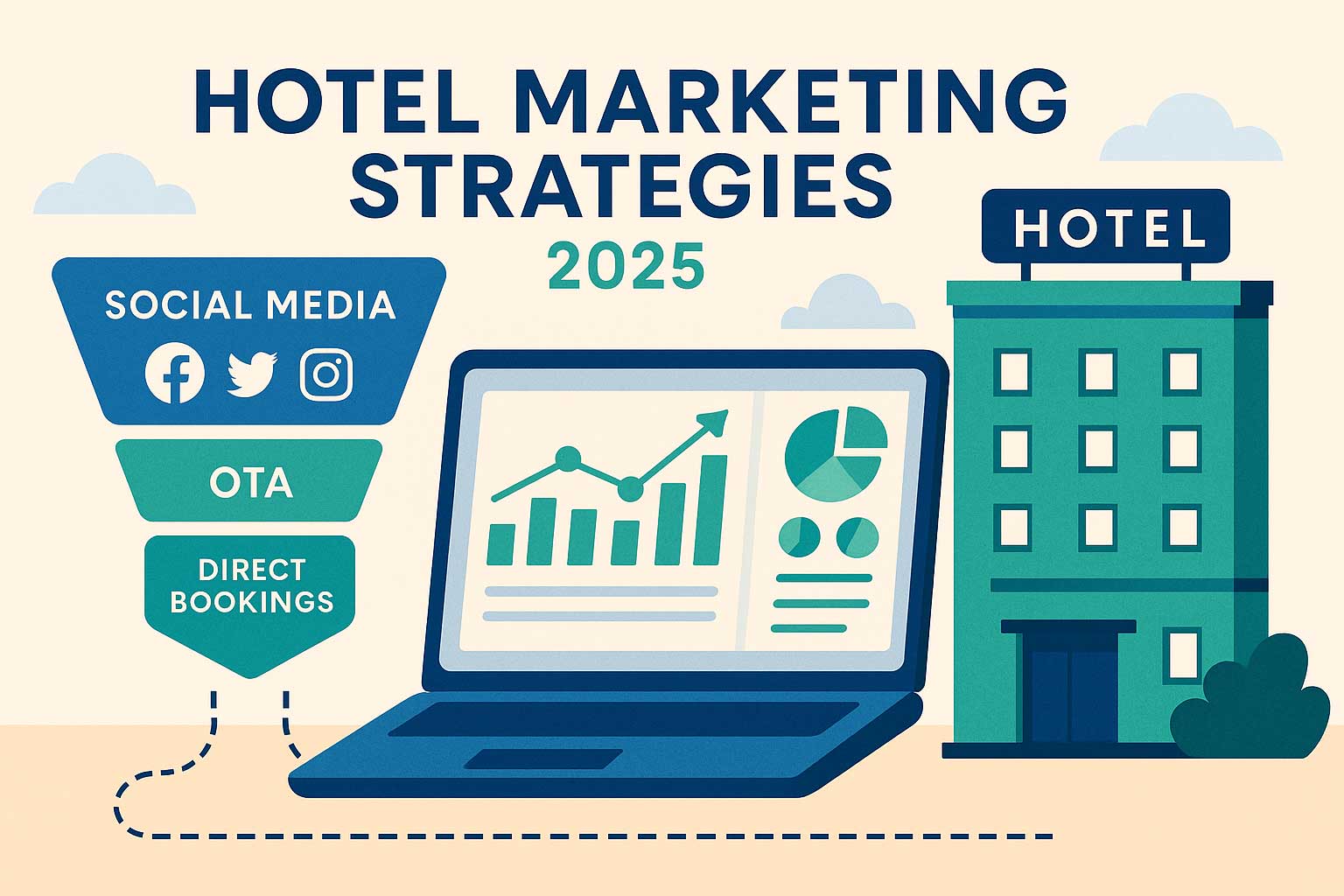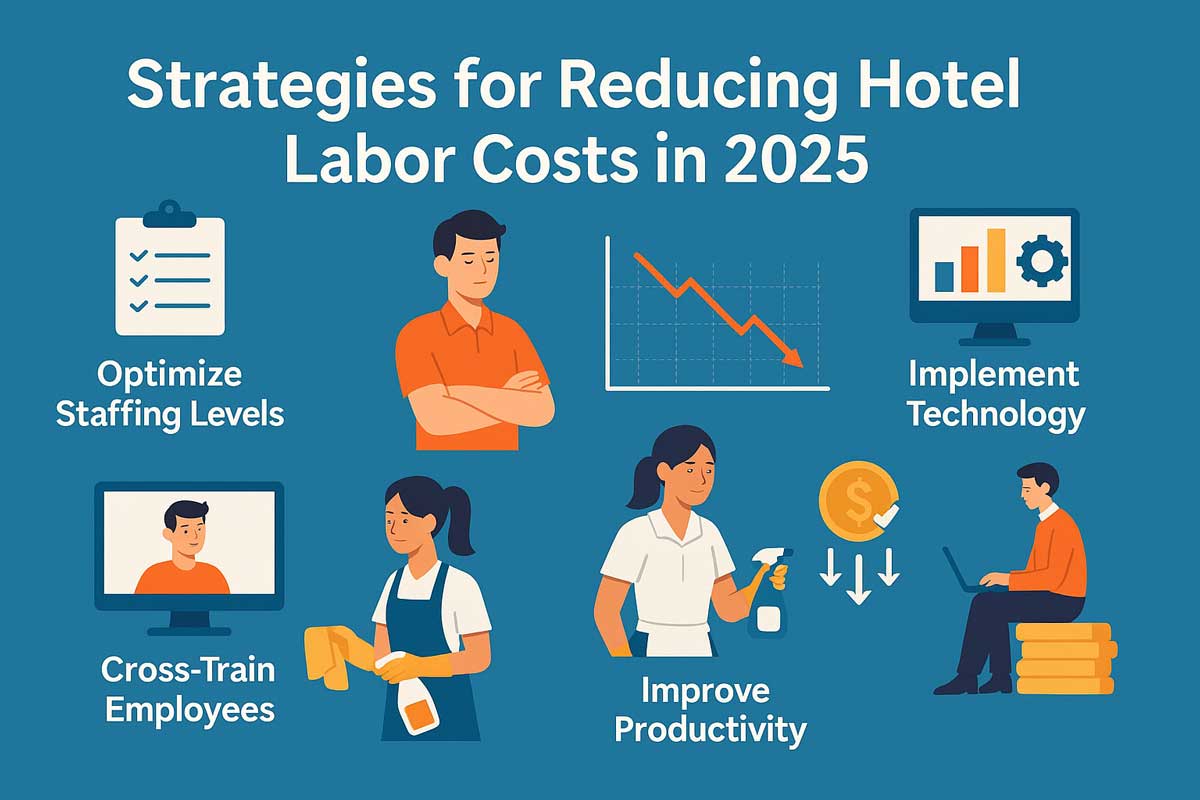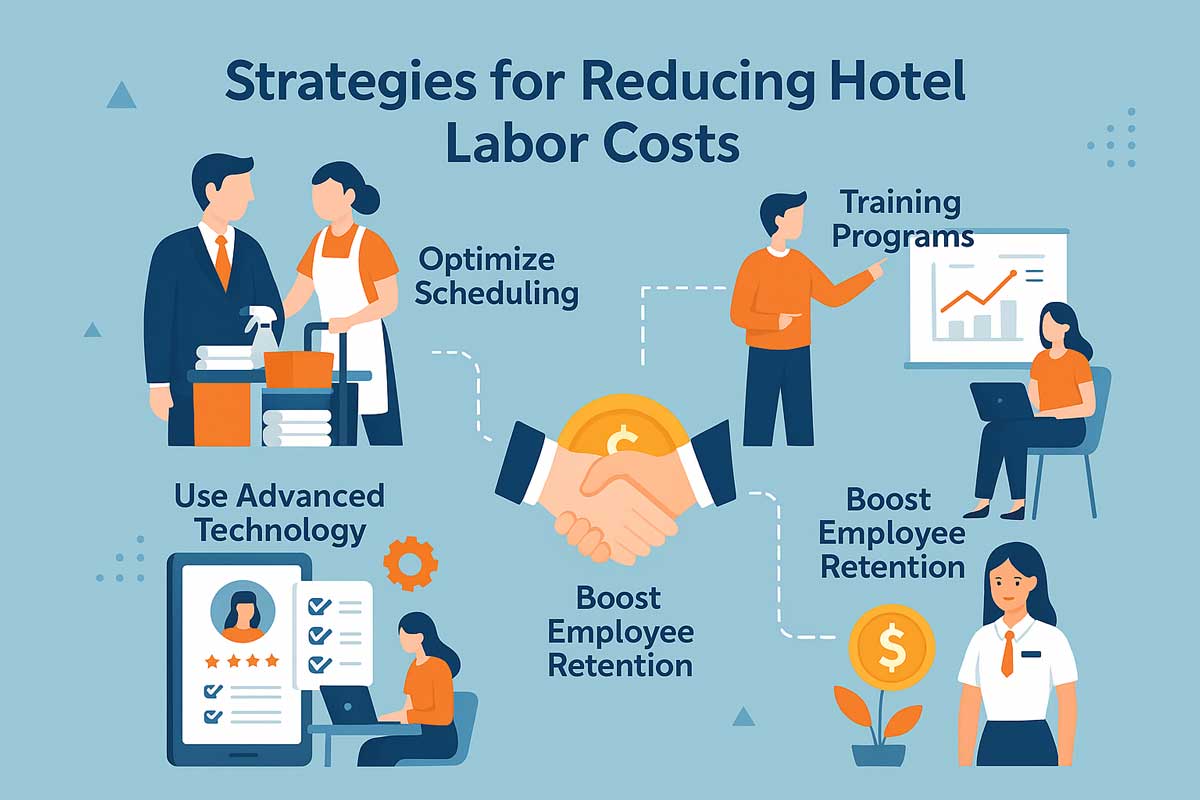Strategies for Reducing Hotel Labor Costs in 2025: A Hotelier’s Guide
Sep 12, 2025
 Mika Takahashi
Mika TakahashiPopular Categories
Hotel Technology & InnovationHotel Operations OptimizationDigital MarketingIndustry TrendsRevenue ManagementHospitality Industry
Popular Categories
Trending Post

Hotel Walk Letter Template: Professional Guest Communication

Online Travel Agents: What They Are and How They Work

Hotel Security Systems: Modern Protection Solutions

Hotel Advertising: Complete Guide to Boost Bookings and Revenue

25 Hotel Marketing Strategy Ideas for 2025: Complete Guide

AI Reservation Agent: Revolutionizing Hotel Booking and Guest Experience

PMS Communication: Streamlining Property Management Through Effective Guest Messaging
Table of contents
Hotel labor costs can account for up to 45% of a hotel’s expenses, making them a critical area to manage wisely. In this article, we’ll break down what makes up these costs and share practical strategies to help you keep them in check without sacrificing service quality.
Key Takeaways
- Hotel labor costs include wages, benefits, and taxes, typically making up 30% to 45% of total operating expenses, so managing them effectively is essential for profitability.
- Leveraging technology like scheduling software and automation can streamline staffing, cut costs, and maintain excellent service.
- Smart scheduling, cross-training employees, and outsourcing non-core tasks are proven ways to boost operational efficiency and reduce labor expenses.
Understanding Hotel Labor Costs

Hotel labor costs are made up of several parts: wages, salaries, employee benefits, and payroll taxes. Together, these often represent a large slice of a hotel’s total operating expenses—usually between 30% and 45%.
Keeping these expenses under control is key to protecting profitability and running a smooth operation.
Wages and Salaries
Wages and salaries are the biggest piece of the labor cost pie, shaping the hotel’s financial health. It’s not uncommon for labor expenses to consume nearly half of a hotel’s total revenue. For example, in places like Los Angeles, labor costs have jumped 36% compared to pre-pandemic times, highlighting the importance of smart wage management.
Employee Benefits
Benefits such as health insurance, retirement plans, and other perks also add up and play a big role in total labor costs. Beyond dollars, offering good benefits helps keep employees happy and motivated, which in turn improves the guest experience and service quality.
Payroll Taxes
Payroll taxes are another crucial part of labor costs. Staying on top of payroll tax rules helps avoid costly penalties and keeps operations running smoothly. These taxes also affect the overall financial picture, so hotel operators need to manage revenues carefully.
Labor Costs Across Hotel Departments
Not all hotel departments have the same labor cost profile, and understanding these differences is key to managing expenses effectively.
Front Office and Guest Services
The front office and guest services team, including receptionists and concierge staff, play a crucial role in shaping the guest experience. Labor costs here are significant due to the need for skilled staff who provide personalized service and manage guest interactions efficiently.
Housekeeping and Maintenance
Housekeeping and maintenance departments are labor-intensive, responsible for room cleanliness and facility upkeep. These areas often represent a large portion of labor expenses, especially during periods of high occupancy, as they directly impact guest satisfaction and operational efficiency.
Food & Beverage Operations
Labor costs in food and beverage operations have seen notable increases, now accounting for about 32% of total hotel labor expenses. This rise is driven by higher demand for dining services and group events, requiring strategic staffing to balance service quality with cost control.
Management and Administrative Staff
Management and administrative teams, while smaller in number, contribute to labor costs through salaries and benefits. Their roles in overseeing operations, budgeting, and compliance are essential for maintaining service standards and protecting profitability.
Trends Influencing Hotel Labor Costs
Several trends are shaping hotel labor costs in 2025, from inflation and labor shortages to the rise of advanced technology. These trends bring both challenges and opportunities for hotel operators navigating major markets through various distribution channels.
Minimum Wage Increases
Rising minimum wages are squeezing hotel operating margins. For example, Los Angeles plans to raise the minimum wage to $30 per hour by 2028, adding pressure on labor expenses that already make up nearly half of total revenue. This calls for thoughtful labor management strategies.
Regulatory Changes
Changes in tariffs and trade policies also affect hotel labor costs by increasing operating expenses and complicating budget management. Hotels relying heavily on government travel or large group events need to carefully balance these factors to protect profitability.
Technology in Labor Management
Technology is becoming a game-changer in labor management, offering tools to optimize staffing and boost operational efficiency. AI-powered talent management, data analytics, and automation are helping hotels move beyond traditional staffing models.
Scheduling Software
Scheduling software lets managers forecast hotel staffing needs more accurately by analyzing data. It also offers employees self-service options for shift management, reducing the burden on managers. For instance, a San Diego hotel cut labor costs by 5-15% after adopting modern scheduling aligned with occupancy forecasts.
Automation and Robotics
Automation and robotics are helping reduce staffing costs by streamlining tasks like front desk check-ins. While some worry this might reduce the human touch, when balanced well, automation can free staff to focus on personalized service that guests appreciate.
Strategies for Reducing Labor Costs

Applying effective strategies to cut labor costs can significantly improve the bottom line while enhancing operational efficiency and guest satisfaction.
Smart Scheduling Practices
Smart scheduling matches staffing levels to actual demand, cutting down on idle time and boosting efficiency. This approach benefits both guests and employees, ensuring service standards stay high.
Cross-Training Employees
Cross-training helps employees develop skills across multiple roles, creating a flexible workforce that can adapt to busy periods or absences. It also improves job satisfaction and reduces dependency on specialized staff.
Outsourcing Non-Core Functions
Outsourcing tasks like laundry or valet parking can save money and improve efficiency. Choosing reliable third-party providers ensures service quality remains consistent while cutting costs.
Strategies to Manage and Optimize Labor Costs
Effectively managing hotel labor costs requires a combination of proactive planning, flexible workforce management, and a focus on maintaining service quality. Here are key strategies that hotel operators can use to optimize labor expenses while ensuring excellent guest experiences.
Forecasting Labor Needs Based on Occupancy
Accurate forecasting of labor needs aligned with occupancy rates is essential for controlling staffing costs. By analyzing historical occupancy data, seasonal trends, and upcoming events, hotels can predict demand and schedule the right number of employees accordingly. This approach helps avoid overstaffing during low-demand periods and understaffing during busy times, optimizing labor expenses per occupied room.
Cross-Training Staff for Flexibility
Cross-training employees across multiple departments increases workforce flexibility and operational efficiency. For example, front desk staff trained to assist in food and beverage departments or housekeeping can fill gaps during peak times or absences. This strategy not only reduces the need for additional hires but also enhances employee engagement and skill development, benefiting both staff and hotel operations.
Implementing Efficient Scheduling Practices
Utilizing scheduling software and adopting smart scheduling practices enable hotel managers to align staffing levels with real-time demand. Efficient scheduling minimizes overtime, reduces idle labor hours, and accommodates employee preferences, leading to higher morale and productivity. Incorporating employee availability and skill sets into scheduling decisions ensures that the right staff are assigned to the right tasks at the right times.
Balancing Service Quality with Cost Control
While controlling labor costs is vital, maintaining high service standards remains a top priority. Hotels must find a balancing act between cost control and service quality by strategically deploying staff where they have the most significant impact on guest satisfaction. Investing in training and empowering employees to deliver personalized service can enhance the guest experience without necessarily increasing labor expenses, ultimately protecting both profitability and reputation.
Hotel Manning Template
The hotel manning template below is a handy guide that helps hotels figure out exactly how many staff members are needed across different departments and shifts. Whether it’s receptionists greeting guests, housekeepers keeping rooms spotless, or security ensuring safety, this template breaks down staffing needs based on how busy the hotel is throughout the day. It makes scheduling simpler and helps avoid overworking employees or leaving guests waiting.
By following this plan, hotels can keep things running smoothly, deliver great service, and manage labor costs more effectively—all while making sure the right people are in the right place at the right time.
| Department | Position | Morning Shift (07:00–15:00) | Afternoon Shift (15:00–23:00) | Night Shift (23:00–07:00) | Notes / Coverage Basis |
|---|---|---|---|---|---|
| Front Office | Receptionist | 2 | 2 | 1 | 1 per 50 rooms |
| Concierge / Bellman | 1 | 1 | – | Adjust for arrivals/departures | |
| Housekeeping | Room Attendants | 1 per 12 rooms | 1 per 20 rooms | – | Based on check-out volume |
| Public Area Attendant | 1 | 1 | 1 | Lobby + public areas | |
| F&B | Restaurant Servers | 1 per 20 guests | 1 per 25 guests | – | Adjust for covers |
| Bartender | – | 1 | 1 | Lounge/Bar service | |
| Kitchen | Chef de Partie / Line Cook | 2 | 2 | 1 | Covers menu demand |
| Dishwasher / Steward | 1 | 1 | – | Support function | |
| Engineering | Maintenance Technician | 1 | 1 | On-call | Rotational shifts |
| Security | Security Officer | 1 | 1 | 2 | 24/7 coverage |
| Management | Duty Manager | 1 | 1 | On-call | Flexible based on occupancy |
How to Use the Template
- Start with occupancy forecast → define expected arrivals, departures, and in-house guests.
- Apply staffing ratios (e.g., 1 room attendant per 12 rooms during check-outs).
- Adjust by shift depending on guest demand patterns.
- Review weekly and update for seasonality or events.
Case Studies: Successful Labor Cost Management

Real-world examples show how hotels have effectively managed labor costs to boost profitability and guest experience.
Komodo Resort
Komodo Resort boosted staff morale and productivity through employee engagement initiatives. By integrating scheduling software with property management systems, they improved staffing efficiency by closely monitoring occupancy patterns, leading to reduced labor costs and happier guests.
Las Vegas Resort
A Las Vegas resort leveraged data analytics and automation to optimize staffing based on guest demand. This approach increased staff efficiency and guest satisfaction, ultimately driving higher profitability.
Persistent Challenges in Labor Cost Management
Despite best efforts, some challenges remain in managing labor costs.
High Turnover Rates
High employee turnover is a costly issue in hospitality. Recruiting, onboarding, and training new staff take time and money, making retention through comprehensive training and a positive workplace culture essential.
Economic Fluctuations
Economic downturns can force budget cuts, affecting staffing levels and service quality. Hotels need flexible staffing models and strategic labor management to weather these ups and downs.
Summary
Managing hotel labor costs in 2025 calls for a well-rounded approach that blends smart scheduling, employee cross-training, and technology adoption. By understanding the different components of labor expenses and keeping an eye on industry trends, hotel operators can boost operational efficiency and enhance guest satisfaction—ensuring long-term profitability and success.
